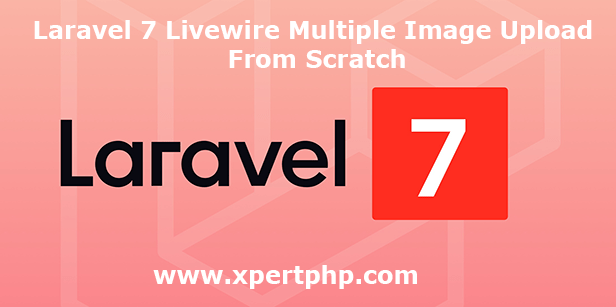
Laravel 7 Livewire Multiple Image Upload From Scratch
In this article, you will receive useful information about the multiple image upload from scratch using livewire in laravel 7(Laravel 7 Livewire Multiple Image Upload From Scratch).
So you can follow the below steps for upload multiple image using livewire in laravel 7.
Overview
Step 1: Install Laravel 7
Step 2: Setting Database Configuration
Step 3: Create Table using migration
Step 4: Install Livewire
Step 5: Create Component
Step 6: Create Route
Step 7: Create a Model
Step 8: Create Blade Files
Step 9: Run Our Laravel Application
Laravel Livewire Multiple Image Upload Example Tutorial
Step 1: Install Laravel 7
We are going to install laravel 7, so first open the command prompt or terminal and go to xampp htdocs folder directory using the command prompt. after then run the below command.
1 | composer create-project --prefer-dist laravel/laravel laravel7_livewire_image |
Step 2: Setting Database Configuration
After the complete installation of laravel. we have to database configuration. now we will open the .env file and change the database name, username, password in the .env file. See below changes in a .env file.
1 2 3 4 5 6 | DB_CONNECTION=mysql DB_HOST=127.0.0.1 DB_PORT=3306 DB_DATABASE=Enter_Your_Database_Name(laravel7_livewire_image) DB_USERNAME=Enter_Your_Database_Username(root) DB_PASSWORD=Enter_Your_Database_Password(root) |
Step 3: Create Table using migration
Now, We need to create a migration. so we will below command using create the images table migration.
1 | php artisan make:migration create_images_table --create=images |
After complete migration. we need below changes in the database/migrations/create_images_table file.
1 2 3 4 5 6 7 8 9 10 11 12 13 14 15 16 17 18 19 20 21 22 23 24 25 26 27 28 29 30 31 32 33 | <?php use Illuminate\Support\Facades\Schema; use Illuminate\Database\Schema\Blueprint; use Illuminate\Database\Migrations\Migration; class CreateImagesTable extends Migration { /** * Run the migrations. * * @return void */ public function up() { Schema::create('images', function (Blueprint $table) { $table->bigIncrements('id'); $table->string('image'); $table->timestamps(); }); } /** * Reverse the migrations. * * @return void */ public function down() { Schema::dropIfExists('images'); } } ?> |
Run the below command. after the changes above file.
1 | php artisan migrate |
Step 4: Install Livewire
Now, We will install a livewire package using the below command.
1 | composer require livewire/livewire |
Step 5: Create Component
Here below command help to create the component.
1 | php artisan make:livewire image-upload |
app/Http/Livewire/ImageUpload.php
1 2 3 4 5 6 7 8 9 10 11 12 13 14 15 16 17 18 19 20 21 22 23 24 25 26 27 28 29 30 31 32 33 34 35 36 37 38 39 | <?php namespace App\Http\Livewire; use Livewire\Component; use Livewire\WithFileUploads; use App\Image; class ImageUpload extends Component { use WithFileUploads; public $images = []; public function render() { return view('livewire.image-upload'); } public function store() { $this->validate([ 'images.*' => 'image|max:1024', // 1MB Max ]); foreach ($this->images as $key => $image) { $this->images[$key] = $image->store('images','public'); } $this->images = json_encode($this->images); Image::create(['image' => $this->images]); session()->flash('message', 'Image successfully Uploaded.'); return redirect()->to('/images'); } } ?> |
Step 6: Create Route
Add the following route code in the “routes/web.php” file.
1 2 3 4 5 6 7 8 9 10 11 12 13 14 | <?php /* |-------------------------------------------------------------------------- | Web Routes |-------------------------------------------------------------------------- | | Here is where you can register web routes for your application. These | routes are loaded by the RouteServiceProvider within a group which | contains the "web" middleware group. Now create something great! | */ Route::view('images','livewire.home'); |
Step 7: Create a Model
Here below command help to create the model.
1 | php artisan make:model Image |
Image.php
1 2 3 4 5 6 7 8 9 10 11 12 13 | <?php namespace App; use Illuminate\Database\Eloquent\Model; class Image extends Model { protected $fillable = [ 'image' ]; } ?> |
Step 8: Create Blade Files
So finally, first we will open the home.blade.php and image-upload.blade.php files and after then paste the following code.
resources/views/home.blade.php
1 2 3 4 5 6 7 8 9 10 11 12 13 14 15 16 17 18 19 20 21 22 23 24 25 26 27 28 29 30 31 | <!DOCTYPE html> <html> <head> <title>Laravel 7 Livewire Multiple Image Upload From Scratch - XpertPhp</title> <script src="{{ asset('js/app.js') }}" defer></script> <link href="{{ asset('css/app.css') }}" rel="stylesheet"> <script src="//ajax.googleapis.com/ajax/libs/jquery/1.12.4/jquery.min.js"></script> @livewireStyles </head> <body> <div class="container"> <div class="row mt-5 justify-content-center"> <div class="mt-5 col-md-8"> <div class="card"> <div class="card-header bg-primary text-white"><h3>Laravel 7 Livewire Multiple Image Upload From Scratch - XpertPhp</h3></div> <div class="card-body"> @if (session()->has('message')) <div class="alert alert-success"> {{ session('message') }} </div> @endif @livewire('image-upload') </div> </div> </div> </div> </div> @livewireScripts </script> </body> </html> |
resources/views/livewire/image-upload.blade.php
1 2 3 4 5 6 7 8 9 10 11 12 13 14 15 16 17 | <div> <form> <div class=" add-input"> <div class="row"> <div class="col-md-12"> <div class="form-group"> <input type="file" class="form-control" wire:model="images" multiple> @error('image.*') <span class="text-danger error">{{ $message }}</span>@enderror </div> </div> <div class="col-md-12 text-center"> <button class="btn text-white btn-success" wire:click.prevent="store">Save</button> </div> </div> </div> </form> </div> |
Step 7: Run Our Laravel Application
We can start the server and run this example using the below command.
1 | php artisan serve |
Now we will run our example using the below Url in the browser.
1 | http://127.0.0.1:8000/images |